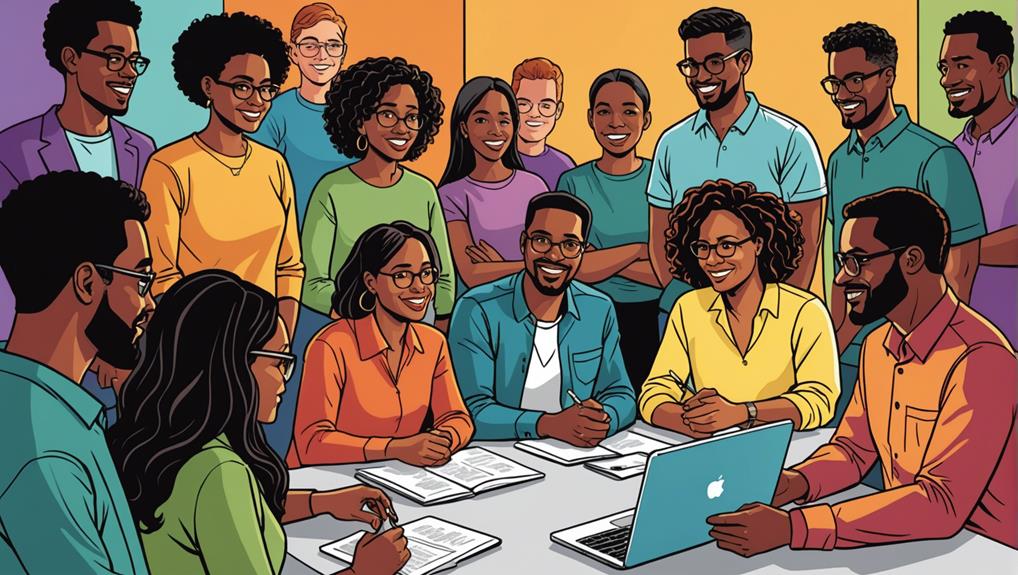Practicing empathy and validation in every interaction helps us connect on a deeper emotional level. We can start by maintaining eye contact and using nonverbal cues like nodding and smiling to show we're present. Paraphrasing what others say and validating their feelings with phrases like, 'I can see why you'd feel that way,' fosters trust and understanding. By stepping into someone else's shoes and genuinely acknowledging their emotions, we create a safe space for open communication. Overcoming personal biases and understanding cultural differences also play significant roles. There are more ways we can build these skills to enhance our interactions further.
Key Takeaways
- Actively listen by maintaining eye contact and using nonverbal cues like nodding and smiling.
- Paraphrase and summarize to show engagement and understanding of the conversation.
- Use validating phrases such as 'I understand why you feel that way' to acknowledge emotions.
- Set aside personal biases and practice perspective-taking to see the world from their viewpoint.
- Recognize and address personal biases to connect genuinely and foster meaningful support.
Understanding Empathy and Validation
Understanding empathy and validation starts with recognizing the significance of connecting with others on a deeper emotional level. When we grasp the feelings of another person, we're not just acknowledging their emotions; we're also creating a supportive environment where they feel seen and heard.
By showing empathy, we can share the feelings of those around us, making them feel valued and respected.
Validation goes hand-in-hand with empathy. It involves accepting and respecting someone's experiences without judgment. This means we don't dismiss or minimize their feelings, but instead, we recognize their emotions as valid and real. Validation fosters trust, communication, and emotional well-being, which are essential for healthy relationships.
When we practice empathy and validation, we enhance our connections with others. We create bonds that are built on mutual understanding and respect. By avoiding invalidation, which can make people feel misunderstood or rejected, we make certain that our interactions are positive and supportive.
In essence, showing empathy and offering validation helps us build a more compassionate and understanding community. It encourages open communication and emotional safety, allowing everyone to feel they belong and are appreciated.
Active Listening Techniques

Active listening is a powerful tool that enables us to connect deeply with others by fully engaging in the moment. When we practice active listening, we focus on the speaker, maintaining eye contact, and offering verbal and nonverbal cues to show our engagement. This process helps us grasp the other person's feelings and thoughts, making them feel heard and valued.
Empathy is the ability to understand and share another person's feelings. By reflecting back their emotions and validating their feelings, we can create a safe space for open communication.
Let's consider some key techniques to enhance our active listening skills:
- Maintain eye contact: This shows the speaker that we're fully present and attentive.
- Use nonverbal cues: Nodding, smiling, and mirroring body language can help convey empathy.
- Paraphrase and summarize: Restating the speaker's words demonstrates that we're engaged in the conversation.
- Validate their feelings: Acknowledge and affirm their emotions, which helps to build trust and rapport.
Validating Emotions Effectively

To validate emotions effectively, we need to genuinely acknowledge and accept the other person's feelings, creating a foundation for open and honest communication. When we validate someone else's emotions, they feel heard and understood. This means we should try to understand their perspective, even if we don't necessarily agree with it. By acknowledging someone's feelings, we're able to create a safe space where they can express themselves without fear of judgment.
Practices like active listening and using validating phrases such as 'I can see why you'd feel that way' or 'That sounds really tough' are essential. These phrases show empathy and help the other person feel that their emotions are legitimate and important. Validating emotions isn't about solving the problem right away but about letting the person know their feelings matter.
When we focus on validating emotions, we reduce emotional pain and initiate healing processes. This approach fosters deeper understanding in our interactions and builds strong relationships.
Ultimately, by validating someone else's emotions, we create an environment where teamwork, problem-solving, and increased intimacy can flourish, making us all feel more connected and supported.
Perspective-Taking Skills

Perspective-taking skills enable us to step into someone else's shoes and see the world from their point of view. These skills are essential for fostering empathy and understanding in our interactions. When we try to understand another person's feelings and experiences, we can better validate someone and make them feel heard and respected. This process involves setting aside our personal biases and judgments to truly see things from another perspective.
To effectively practice perspective-taking, we need to focus on several key areas:
- Listen actively: Pay close attention to what the other person is saying without interrupting.
- Observe body language: Notice non-verbal cues that can provide insight into their feelings.
- Ask open-ended questions: Encourage them to share more about their thoughts and experiences.
- Reflect back: Paraphrase what they've said to show that you understand and care.
Overcoming Empathy Barriers

Recognizing and addressing our personal biases is essential for overcoming barriers to empathy. When we grasp that everyone comes from different backgrounds and experiences, we can better connect with someone's emotions. It's important to keep in mind that what makes sense to us mightn't click with another person, and that's okay. By acknowledging this, we take the first step toward true comprehension.
Sometimes, we might feel overwhelmed when trying to empathize, especially if we're having a hard time managing our own emotions. That's why setting clear boundaries is vital. It's okay to prioritize self-care and seek support when we need it. This helps prevent empathy fatigue and ensures we can continue to offer genuine empathy without burning out.
Understanding diverse cultural expressions of empathy also plays a significant role. What feels like a supportive gesture to us might be different for someone from another culture. By learning about these differences, we can improve our cross-cultural communication and offer more meaningful support.
Frequently Asked Questions
How to Show Empathy and Validation?
To show empathy and validation, we need to actively listen, making sure we're fully present and engaged.
Let's acknowledge their feelings by saying things like, “I understand how you feel,” or “That sounds really tough.” Non-verbal cues, such as nodding and maintaining eye contact, help too.
Reflecting back what they've said shows we're truly listening and validating their emotions, building trust and emotional connections.
What Is an Example of Validation and Empathy?
An example of validation and empathy is when a friend shares they're feeling overwhelmed, and we say, 'I can see you're really stressed, and that makes sense given everything on your plate. It's okay to feel this way.'
What Is Validation Through Empathy?
Validation through empathy is like a bridge connecting our hearts. We acknowledge and respect others' feelings and experiences, understanding and accepting the validity of their emotions.
This fosters emotional connection and promotes open communication. By truly listening and showing empathy, we create a safe, supportive environment where meaningful interactions can thrive.
Let's remember, validating emotions isn't just about agreeing, but about genuinely understanding and valuing someone's perspective.
Why Do I Always Need Someone to Validate My Feelings?
We often need someone to validate our feelings because it helps us feel understood, valued, and connected. When others acknowledge our emotions, it reassures us that we're not alone in our experiences.
This validation can boost our self-esteem and emotional well-being, fostering trust and intimacy in relationships. It's natural to seek this affirmation, as it confirms that our feelings are real and important, contributing to our overall emotional health.
Conclusion
As we navigate our daily interactions, let's remember the power of empathy and validation.
Imagine transforming our conversations by actively listening, truly understanding emotions, and taking others' perspectives.
We'll face barriers, but overcoming them will deepen our connections.
Picture a world where everyone feels heard and valued—it's within our reach.
By practicing these skills, we're not just improving our relationships; we're fostering a more compassionate and supportive community for all.
Let's start today.










